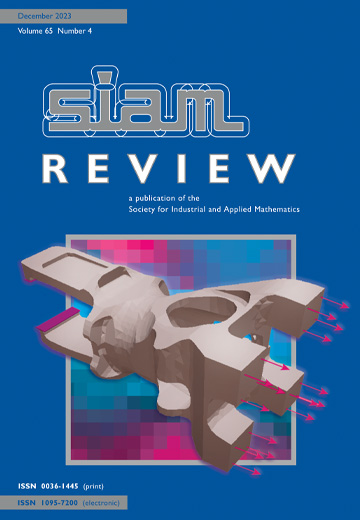论和超越成像中的全变分正则化:空间方差的作用
IF 10.8
1区 数学
Q1 MATHEMATICS, APPLIED
引用次数: 0
摘要
SIAM评论,第65卷第3期,第601-685页,2023年8月。在过去的30年里,应用数学界提出了大量用于图像重建的变分正则化模型,并对其进行了彻底的检验。其中,在数学图像处理的基础课程中经常教授和学习的开创性原型是著名的Rudin-Osher-Fatemi(ROF)模型[L.I.Rudin,S.Osher和E.Fatemi,Phys.D,60(1992),pp.259-268],该模型依赖于将保边全变差(TV)半形式最小化作为正则化项。尽管该模型(通常是有限的)简单性,但由于其全面的分析和数值理解,该模型仍在许多应用中得到了广泛应用,并被用作评估现代基于学习的图像重建方法性能的基准。在多年来提出的许多电视扩展中,有一个大类是基于空间方差的概念。空间变量模型确实可以通过自适应数学建模克服TV描述局部特征(强度、锐度、方向性)的固有能力,该数学建模适应局部正则化加权、可变平滑度和各向异性。这些想法可以进一步体现在广义高斯分布的灵活贝叶斯框架中,并与最大似然和分层优化方法相结合,以实现高效的超参数估计。在这项工作中,我们回顾并联系了空间变体电视类型图像重建模型领域的主要贡献,特别是它们的贝叶斯解释,这为新的令人兴奋和未探索的研究方向铺平了道路。本文章由计算机程序翻译,如有差异,请以英文原文为准。
On and Beyond Total Variation Regularization in Imaging: The Role of Space Variance
SIAM Review, Volume 65, Issue 3, Page 601-685, August 2023.
Over the last 30 years a plethora of variational regularization models for image reconstruction have been proposed and thoroughly inspected by the applied mathematics community. Among them, the pioneering prototype often taught and learned in basic courses in mathematical image processing is the celebrated Rudin--Osher--Fatemi (ROF) model [L. I. Rudin, S. Osher, and E. Fatemi, Phys. D, 60 (1992), pp. 259--268], which relies on the minimization of the edge-preserving total variation (TV) seminorm as a regularization term. Despite its (often limiting) simplicity, this model is still very much employed in many applications and used as a benchmark for assessing the performance of modern learning-based image reconstruction approaches, thanks to its thorough analytical and numerical understanding. Among the many extensions to TV proposed over the years, a large class is based on the concept of space variance. Space-variant models can indeed overcome the intrinsic inability of TV to describe local features (strength, sharpness, directionality) by means of an adaptive mathematical modeling which accommodates local regularization weighting, variable smoothness, and anisotropy. Those ideas can further be cast in the flexible Bayesian framework of generalized Gaussian distributions and combined with maximum likelihood and hierarchical optimization approaches for efficient hyperparameter estimation. In this work, we review and connect the major contributions in the field of space-variant TV-type image reconstruction models, focusing, in particular, on their Bayesian interpretation which paves the way to new exciting and unexplored research directions.
Over the last 30 years a plethora of variational regularization models for image reconstruction have been proposed and thoroughly inspected by the applied mathematics community. Among them, the pioneering prototype often taught and learned in basic courses in mathematical image processing is the celebrated Rudin--Osher--Fatemi (ROF) model [L. I. Rudin, S. Osher, and E. Fatemi, Phys. D, 60 (1992), pp. 259--268], which relies on the minimization of the edge-preserving total variation (TV) seminorm as a regularization term. Despite its (often limiting) simplicity, this model is still very much employed in many applications and used as a benchmark for assessing the performance of modern learning-based image reconstruction approaches, thanks to its thorough analytical and numerical understanding. Among the many extensions to TV proposed over the years, a large class is based on the concept of space variance. Space-variant models can indeed overcome the intrinsic inability of TV to describe local features (strength, sharpness, directionality) by means of an adaptive mathematical modeling which accommodates local regularization weighting, variable smoothness, and anisotropy. Those ideas can further be cast in the flexible Bayesian framework of generalized Gaussian distributions and combined with maximum likelihood and hierarchical optimization approaches for efficient hyperparameter estimation. In this work, we review and connect the major contributions in the field of space-variant TV-type image reconstruction models, focusing, in particular, on their Bayesian interpretation which paves the way to new exciting and unexplored research directions.
求助全文
通过发布文献求助,成功后即可免费获取论文全文。
去求助
来源期刊

SIAM Review
数学-应用数学
CiteScore
16.90
自引率
0.00%
发文量
50
期刊介绍:
Survey and Review feature papers that provide an integrative and current viewpoint on important topics in applied or computational mathematics and scientific computing. These papers aim to offer a comprehensive perspective on the subject matter.
Research Spotlights publish concise research papers in applied and computational mathematics that are of interest to a wide range of readers in SIAM Review. The papers in this section present innovative ideas that are clearly explained and motivated. They stand out from regular publications in specific SIAM journals due to their accessibility and potential for widespread and long-lasting influence.
 求助内容:
求助内容: 应助结果提醒方式:
应助结果提醒方式:


